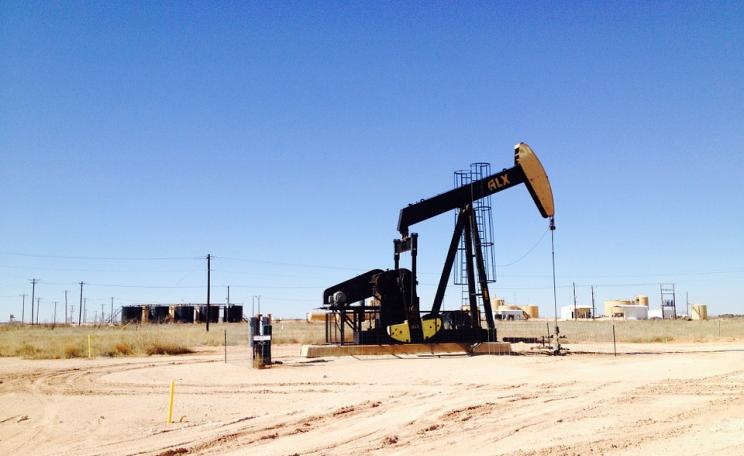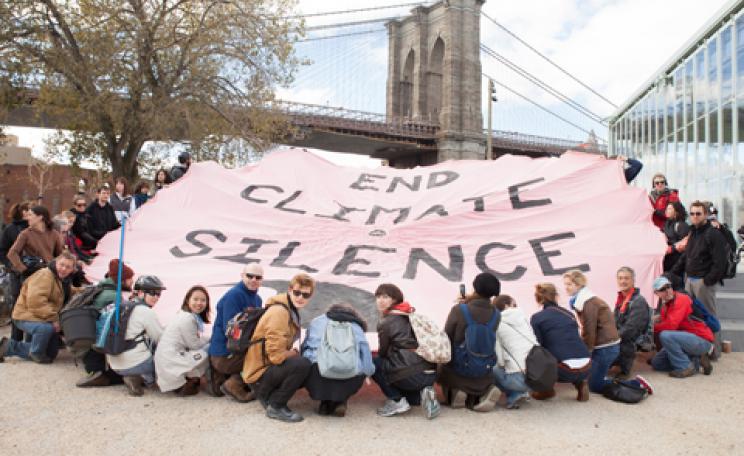I see this resistance seething among people of all ages wherever I go
The directions take us just outside the New York City sprawl-zone: up through the hills and bare forests of late winter, the houses and yards getting bigger until they disappear altogether and suddenly we’re nearing the highest point in New Jersey and one of the more strenuous parts of the Appalachian trail.
We’re here to check on the last stand of trees to be cleared for loop 323 of the proposed Tennessee Pipeline, which would run through the heart of the Marcellus Shale in Pennsylvania, opening new areas to fracking and fueling the proposed 1,120MW Newark Generating Station.
My friend and I have been working with a group called Tar Sands Blockade to oppose the Keystone XL tar sands pipeline in Texas. We came here to offer our support to locals in New Jersey and Pennsylvania who have been climbing into trees, blockading access roads, and locking themselves to trees in order to stop the Tennessee Pipeline since mid-February.
We arrive too late– the day’s standoff with workers and police ended just before we arrived. Matt Smith and Jerome Wagner had locked themselves to trees along the pipeline’s right-of-way, stopping work. Eventually the police came with tools to cut the locking device apart. An observer from the Ramapough Luunape nation helped negotiate with police so that the two protesters could unlock, leave without being arrested, and keep the device intact.
Long before dirty energy companies began to frack Pennsylvania, the Ramapough Lunape were suffering from buried poison leaching into their groundwater. In the 1960’s and 1970’s, the Ford Motor Company dumped waste into abandoned mineshafts on their land. The Ringwood Mines landfill site is now a Superfund site. Seven hundred of the thirty-five hundred people in the tribe have documented health impacts; one fourth of homes has at least one person with cancer.
The Ramapough Luunape do not want the pipeline on their land. The observer was there to document violations by the construction crew and ensure that culturally and archaeologically important sites weren’t being destroyed.
At the same time the anti-fracking activists were stopping work at the construction site, over forty angry citizens were refusing to comply with the designated “public comment period” at the Delaware River Basin Commission’s (DRBC) public meeting and calling out the representatives of the commissioners, president Obama and governors Jack Markell of Delaware, Chris Christy of New Jersey, Tom Corbett of Pennsylvania, and Mario Cuomo of New York, for refusing to exercise any of their regulatory powers over the Tennessee Pipeline or any of the other fracked gas pipelines which would cross the Delaware River.
I see this resistance seething among people of all ages wherever I go
They are there because the fracking infrastructure – from the drilling pads to the pipelines to the power plants – is tearing up the land they’ve hiked, hunted and fished in for years, seizing peoples’ property through eminent domain (we met one man who will soon have to deal with Kinder Morgan digging a trench through his septic line), and making their water dangerous to drink.
The people here have long memories of being told to suffer for someone else’s gold rush, to lose their health or land to development projects ostensibly for the “public good”. The pipeline will cut across George and Marsha FIgnes’ property. George Feigner, 86 years old, had to fight to keep his home years ago, beginning in the late 1950’s when the proposed Tocks Island Dam would have put his entire community at the bottom of a forty-mile lake. The Delaware River Gap National Recreation Area exists today because the community won that struggle. There were riots, and the police tear-gassed people out of their homes, but the dam was never built.
After introducing us to the Jersey residents who had spent the morning locked to trees (their first direct action), Alex Lotorto of Stop Tennessee Pipeline is showing us where the pipeline will cross the Appalachian trail. Alex and his father, who made his voice heard at that morning’s DRBC meeting, have fought the fracking industry since 2008 when it first threatened the hills and streams they have hunted and fished in for decades. Alex has walked onto construction sites, locked himself to access gates, and climbed trees in the path of the Tennessee Pipeline.
As we hike in, Alex explains that we are checking on the last stand of trees left in the path of the pipeline. He hopes that the oaks will still be standing. Alex or someone else could climb one of those trees and stall construction, hopefully delaying the project enough to raise awareness and make Kinder Morgan and their investors nervous.
The trees are dead. They lie in piles alongside the pipeline easement. The clearing crews move fast. We’ve seen just how fast in Texas, where the same contractors, Northern Tree Clearing and Michel’s, are clear-cutting for Keystone XL.
We stand on the ridge, a short walk from the top of New Jersey, and look at the wide scar that runs as far as we can see, marked by a long line of surveyor ribbons flying like the pennants of an invading army. The view would be impeccable otherwise: rolling hills of pristine, snow-fringed hardwood forest.
It’s a rare, desolate moment. For the three of us, bundled against the dry, cold winds sweeping through the newly exposed slopes, a sense of loss pervades the skeletal March landscape. We know that Stop the Tennessee Pipeline’s struggle will continue – somewhat changed now that fewer opportunities for tree-sits exist – but we were too late for these trees.
The increasingly desperate dirty energy barons are plumbing poisons across the continent, tearing up whoever or whatever gets in the way. Communities are being poisoned by mines, by fracking wells, by catastrophic pipeline failures, and by the carcinogenic refineries and power plants at the end of the line. All for a buck. For all the distractions and addictions money can buy.
I have felt the same ennui when I come across a newly ravaged KXL easement in Texas. I am often struck by the intersectionality of different anti-extraction struggles; not just against pipelines like the Tennessee and Keystone XL but against oil-driven deforestation of indigenous land in the rainforests of Central and South America, against the demolition of whole Appalachian mountains for the sake of expanding a coal-fired generating grid that already kills 25,000 people every year in the United States.
The same few people are responsible: the investors who don’t care where their money comes from, the dirty energy execs, every politician whose regime is maintained by oil-lobby contributions, and the corporate media hacks who blithely focus every report around the issue of “job creation” as we face the greatest ecological disaster in history.
Contrary to popular portrayals of the anti-extraction movement as some kind of youth fad, I see resistance seething among people of all ages wherever I go. Scars run deep, and people like Chief Vincent Mann of the Ramapough Luunape remember a lifetime of exploitation by toxic industry. His people’s past-and-present struggles against Ford and Kinder Morgan echo dozens of similar histories of abuse from the last century.
In Texas, I have heard many of these stories - stories of greed and corruption and rank old crimes, half buried beneath the red trampled earth. In Winona, Texas, anti-Keystone XL Tar Sands Blockaders who halted construction by climbing inside the pipeline itself took photos of visible holes in the welding of the pipeline, which will carry tar sands: one of the dirtiest, hardest to clean, most carcinogenic and teratogenic of the poisons which constitute the lifeblood of the fossil fuel industry.
The pipe segment with those holes was laid in the ground – uninspected and unrepaired – dozens of feet from homes in a predominantly African-American community in Winona, Texas. In a mostly white county, it’s no coincidence that Keystone XL was routed through this community. The petrochemical industry has a long history of building its dangerous, toxic infrastructure through low income communities and communities of color because these communities have less political access and a limited ability to pay for legal opposition.
Despite the obstacles, Winona received national attention in the mid 90’s when a group called MOSES (Mothers Organizing to Stop Environmental Sins) successful shut down the Texas wing of the American Ecology Corporation, which had been secretly dumping toxic waste in their neighborhood.
People have had enough. This movement will not stop with petitions and orderly rallies outside government buildings. “They’re the third largest energy company in the country, but they’re still not allowed to kill a human being,” says Alex. Alex and others like him who put their bodies in the path of the machines are proving that the anti-extraction fight is about much more than asking a few privileged leaders to do the right thing.
The anti-extraction movement is about traditionally marginalized people standing up to build a better future: people like the Appalachia Resist! activists who shut down a fracking waste facility in Ohio on February 18th, like the members of the Red Lake tribe currently blocking an Enbridge tar sands pipeline through their land in northern Minnesota, like Debra White Plume and others from the Oglala nation who started blockading Keystone XL machinery in early 2012 and inspired an ongoing campaign of direct actions against the project.
At its heart, this struggle is about community resistance and resilience. It’s about stopping these insane projects and doing it together in a way that works toward a more just, liberated world for all people, that strengthens our communities and prepares us for the coming storms and struggles of the twenty-first century. There will be many more setbacks like the loss of those old Hemlocks along the Appalachian trail, but the movement will carry on. Alex, for one, isn’t going anywhere. This is his home. He’s as determined as ever to save what’s left of it.
Eric Moll is a freelance journalist and activist, specialising in environmental reporting
*image courtesy of www.shutterstock.com
If you found this article interesting and enjoy reading articles on the Ecologist website, please consider making a donation to support the continuation of this free service.






